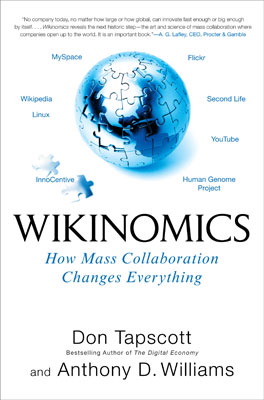Wikinomics Speed Summary

 Wikinomics: How Mass Collaboration Changes Everything
Wikinomics: How Mass Collaboration Changes Everything- Author: Don Tapscott and Anthony D. Williams
- Publisher: Portfolio Hardcover
- Publication date: December 28, 2006
You’ve heard of Wikipedia, the Web 2.0 poster child and the planet’s favourite encyclopaedia. But what’s ‘Wikinomics’ – the new buzzword taking the business world by storm?
Surfing the Web 2.0 Wave
Wikinomics is the bestselling business book with a name inspired by Wikipedia – the user-generated online encyclopedia that’s free to use and that anyone can edit. Wikinomics is a book about collaborative innovation – harnessing the collective intelligence of markets through mass collaboration to innovate better, faster and more cost-effectively. Based on the findings of a 4 year $9m research program, the authors – Don Tapscott and Anthony Williams – argue that the future of successful innovation is innovating with markets, not merely for them.
Wikinomics – the art and science of collaborative innovation – is all about finding ways to innovate with your market – working with partners, customers, consumers and even competitors and regulators to source, shape and screen innovations. Take Procter and Gamble, who have set up an innovation network of 1.5 million external experts and enthusiasts who work together virtually with internal R&D teams. Collaborative innovation is now responsible for nearly 50% of P&G’s new product launches, with the old not-invented-here curse being replaced by a new innovation mantra: PFE – proudly found elsewhere.
Why collaborate when you can go it alone? Well, the reality is that most brands are simply bad at innovation. Going it alone can be pretty much synonymous with failure. For example, failure rates for new product introductions in consumer goods stands at a jaw-dropping 90%. The innovation machine is broken. So when a “perfect storm” emerges of cost-effective online collaborative technology (“Web 2.0”), of people ready to use it (the rise of Net Gen – digital natives), and proof points demonstrating the value of online business collaboration, then we all get interested.
Collaborative Innovation: Better, Faster, Cheaper
Collaborative innovation is a better way to innovate because by innovating with markets you get products that people actually want – and therefore you sell more. For example, 3M find that product ideas from lead users generate eight times the revenue of ideas generated internally. Similarly Muji find that their web-based open design competitions, in which people submit and vote on new product designs, such as their new beanbag sofa chair, produce products that outsell typical products by up to 100:1.
Collaborative innovation is faster (“wiki” means fast in Hawaiian) because Web 2.0 technology (Web 1.0 = web sites, Web 2.0 = web services) allows businesses to connect, collaborate and co-create instantly and continuously. For example, Nestlé Food Services found that by working with their target customers, chefs, they could cut development time of new foods from 26 weeks to 3. In an era where speed to market is a critical success factor, collaborative innovation is a solution for accelerating innovation.
Collaborative innovation can also be cheaper than traditional innovation because – quite apart from mitigating the cost of failure – in the new world of collaborative innovation businesses need only pay for successful ideas. For example, Canadian gold mining group Goldcorp posted its geological survey data available online for download with a challenge: $575,000 prize to anyone who could analyse the data and suggest places where gold could be found. The contest produced 110 targets, over 80% of which proved productive; yielding 8 million ounces of gold, worth more than $3 billion.
Ready for the Wikinomics Way?
To collaborate or not to collaborate, that is the innovation question. Wikinomics provides a quick checklist of four key organizational values you’ll need to profit from the collaborative innovation opportunity:
- Openness: Are you ready to open up infrastructures and intellectual property to the market as Amazon, eBay and Google have done to accelerate and extend the reach of innovation?
- Peering: Can you cultivate a genuine team culture for innovation that extends beyond the borders of your organization with a platform where employees, partners, customers, consumers and regulators work together as peers to produce value?
- Sharing: Are you in a position to develop mutually beneficial exchanges with external partners, as IBM has done with Linux, recognizing the free operating system as an opportunity rather than a threat? By investing in Linux, IBM saves itself $1bn a year developing and maintaining a proprietary operating system
- Acting Globally: Can your business think global and act global? We have a global economy, we live in a global village, and the web is a global innovation and delivery platform – so innovation teams not only need to think global, they must act global as well.
Answer yes to some or all of these questions and your innovation department might be ready to shift gear, and begin harnessing the collective intelligence of the market through mass collaboration, so reaping the rewards of collaborative innovation.




